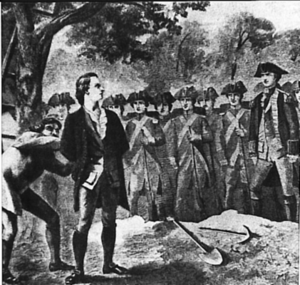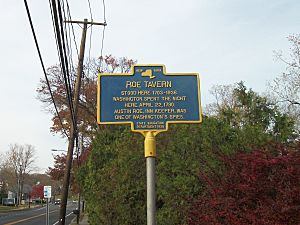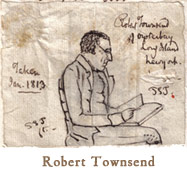Culper Ring facts for kids

Colonel Benjamin Tallmadge, leader of the Culper Ring, in a 1790 portrait with his son William
|
|
| Formation | 1778 |
|---|---|
| Founder | George Washington |
| Dissolved | 1783 |
| Type | military spy ring |
| Purpose | to provide military intelligence from British-occupied New York |
| Headquarters | Setauket and New York City |
|
Leader
|
Colonel Benjamin Tallmadge |
|
Key people
|
Abraham Woodhull, Robert Townsend, Caleb Brewster, Austin Roe, Anna Strong, Agent 355 |
The Culper Ring was a secret group of spies during the American Revolutionary War. Major Benjamin Tallmadge and General George Washington started this group in 1778. This was when the British army controlled New York City. The name "Culper" came from George Washington. He got the idea from Culpeper County, Virginia.
The main leaders of the spy ring were Abraham Woodhull and Robert Townsend. They used secret names: "Samuel Culper Sr." and "Samuel Culper Jr." Tallmadge himself was known as "John Bolton."
Tallmadge was the spies' direct contact. But Washington often told them what to do. The group's job was to give Washington information about the British Army in New York City. This city was the British headquarters. The spies worked mostly in New York City, Long Island, and Connecticut. They were active from late 1778 until the British left New York in 1783.
The Culper Ring gave important information to Washington. For example, they warned about a surprise attack on French forces. These forces were led by Lieutenant General Rochambeau in Newport, Rhode Island. The spies also found out about a British plan. The British wanted to make fake American money using real paper. This made the Continental Congress stop using those bills.
In 1779, the ring told Washington that Tryon's raid was a trick. It was meant to split his army. This would let Lieutenant General Sir Henry Clinton attack them easily. In 1780, the Culper Ring found out something huge. A high-ranking American officer was secretly working with the British. This officer was Benedict Arnold. He was planning to give the important fort at West Point, New York to the British.
Contents
Why Spies Were Needed
Early Spy Efforts and Challenges

Before the Culper Ring, George Washington got information from individual spies. But these spies worked alone. They didn't have much direction. For example, Captain Nathan Hale went to New York City as a spy. But the British quickly caught him. They executed him in 1776.
This made Washington realize something important. He needed a better, more secret spy system. He thought civilians would attract less attention than soldiers. So, he asked William Duer to suggest a good agent. Duer suggested Nathaniel Sackett. Sackett had some success. He found out the British were building boats to attack Philadelphia. But Washington felt he wasn't fast enough.
Other spy networks were tried. Colonel Elias Dayton set up a network on Staten Island. This worked with the Mersereau Ring. After the British took Philadelphia in 1777, Washington focused on getting information there. He gave this job to Major John Clark. Clark set up a good network. But he had to stop due to poor health.
How the Culper Ring Started
Building the Secret Network
In 1778, Lieutenant Caleb Brewster offered to help Washington. Brewster was based in Norwalk, Connecticut. His first report gave details about British warships. Washington then asked General Charles Scott to work with Brewster. Scott was helped by Tallmadge. Scott gave most of the work to Tallmadge. Washington asked Tallmadge to find reliable spies in New York City.
Tallmadge suggested a childhood friend for Brewster's contact. This was Abraham Woodhull from Setauket on Long Island. Woodhull had been arrested for illegal trading. Tallmadge arranged his release. Washington approved Woodhull as a spy. Washington suggested the secret name "Samuel Culper." This name came from Culpeper County, Virginia. Washington had worked there as a surveyor when he was young.
Scott and Tallmadge had different ideas. Scott liked spies who did one mission and came back. Tallmadge wanted spies who stayed hidden behind enemy lines. Scott lost three out of five spies he sent into New York City. So, Washington decided to use Tallmadge's method. Scott resigned in October. Tallmadge became the new intelligence chief.
First Missions and Challenges

Woodhull went to New York City every few weeks to gather information. His married sister, Mary Underhill, lived there. This gave him a reason to visit. He was questioned by British soldiers in October 1778. This made him very nervous. But he returned with important information about British supplies. He proved his worth as a spy.
At first, Woodhull had to go back to Setauket to send messages to Caleb Brewster. Brewster would then take them to Tallmadge. Tallmadge set up couriers in December. These couriers would carry messages between New York and Setauket. Austin Roe became the main courier. He would get letters to Brewster. Brewster would pick up messages at secret coves near Setauket. He would then take them across Long Island Sound to Tallmadge in Connecticut. Tallmadge would then send them to Washington.
Local stories say that Anna Strong helped the spy ring. She lived in Setauket and was a friend of Abraham Woodhull. She supposedly used her clothesline to send signals. If she hung a black petticoat, it meant Brewster was in town. White handkerchiefs showed which of six hiding places he was in. Woodhull used these signals to meet Brewster or drop messages. Historians say this story is hard to prove. But the British did suspect a Setauket woman of helping the Patriots.
Woodhull became very worried about being caught. In June 1779, a privateer told British officers that Woodhull was suspicious. Colonel John Graves Simcoe came to Setauket to find Woodhull. But Woodhull was in New York City. Simcoe's men attacked Woodhull's father. Abraham Woodhull escaped arrest because a Loyalist officer vouched for him. Woodhull reported that he couldn't work in New York City anymore. But he had a new agent ready to help.
Growing the Spy Network
Robert Townsend Joins the Ring
In June 1779, Woodhull brought Robert Townsend into the group. Townsend would gather information in New York City. He used the secret name "Samuel Culper Jr." Townsend was a businessman in the city. His presence would not look suspicious. He could get close to British officers through his tailoring business. He also wrote for a Loyalist newspaper. He even owned part of a coffeehouse with the newspaper's owner, James Rivington. Rivington was also a secret member of the Culper Ring.
Once Townsend started spying, Woodhull mostly stayed in Setauket. The communication network changed. Townsend would give information to a courier, usually Austin Roe. Roe would take it to Setauket. He would leave it for Woodhull in a hidden box in a field. Woodhull would read it and add his own notes. Then he would give it to Brewster. Brewster would take it across Long Island Sound to Tallmadge. Tallmadge would add a cover letter and send it to Washington.
Another courier, Jonas Hawkins, became too nervous. Townsend didn't like working with him anymore. So, Austin Roe became the only permanent courier for the ring in September 1779.
Keeping Secrets Safe
The Culper Ring was very secret. Even Washington didn't know the real names of all the spies. Townsend was especially careful about keeping his identity hidden.
The spies used special ways to send messages. They used invisible ink, also called a "sympathetic stain." They would write secret messages between the lines of normal-looking letters. At first, they used simple codes. For example, Woodhull used code 10 for New York and 20 for Setauket.
Tallmadge realized they needed more codes. By July 1779, he made small code books. These books had lists of words, people, and places with secret numbers. Washington, Woodhull, Townsend, and Tallmadge each had a copy. This made sure the codes didn't fall into enemy hands. The code book helped Washington make sure the Culper Ring spies were safer than earlier spies, like Nathan Hale. Washington's own code number was 711.
Other Helpers and Informants
The Culper Ring got information from many people. Some were not even spies themselves. These helpers included Joseph Lawrence, a Long Island resident. Captain Nathan Woodhull, Abraham Woodhull's uncle, was a Loyalist officer. But he gave information to Abraham. Nathaniel Ruggles was a schoolmaster. Joshua Davis and George Smith helped Brewster with his boat. William T. Robinson was a merchant.
Some historians believe "John Cork" was a secret name for an unknown informant. This person pretended to support the British. This allowed him to travel to New York City. He was said to be very close to British headquarters. He sent reports to Tallmadge in invisible ink. Washington and Tallmadge thought he was a valuable spy.
In 2015, a letter was found that named Nathaniel and Phillip Roe as helpers. Nathaniel gave information. Phillip gave supplies. This letter also showed that the Culper Ring worked in other areas beyond Setauket and Oyster Bay.
Hercules Mulligan and Cato
Hercules Mulligan was another spy for the American army in New York City. Alexander Hamilton recruited him. Mulligan was a friend of Townsend's father. He also helped Hamilton when he first came to New York. Mulligan had a popular clothing business. This gave him a chance to talk to British officers. They would often talk openly about military plans.
Mulligan started spying before the Culper Ring was formed. He worked with the Culper Ring, but often as a single agent. Alexander Rose says Mulligan gave information to Townsend. Townsend then added it to his reports. Mulligan's enslaved helper, Cato, was a loyal partner in his spy work. In 1779, Cato delivered a message from Mulligan to Alexander Hamilton. It warned that the British planned to kidnap or kill American leaders, including Washington.
The British arrested Mulligan because they suspected him of spying. This happened after Benedict Arnold switched sides. Townsend stopped his spy work for a while. He was afraid he would be caught too. Arnold didn't have strong proof against Mulligan. So, Mulligan was released. He continued to gather information after he got out of prison.
Mulligan found out that the British planned to ambush Washington. This was when Washington was going to meet Rochambeau in March 1781. Mulligan and Cato were still suspected. So, Mulligan gave the information to Townsend. Townsend sent it to Washington through the Culper Ring. The message arrived in time. Washington was able to avoid the trap and take a different route.
Women Spies
Women were often not seen as a threat by military leaders. This allowed them to spy more easily. Women who worked as cooks or maids were recruited to spy on soldiers. A famous woman in the Culper Spy Ring was Agent 355. She is known for providing information that led to the capture of Benedict Arnold.
Some sources say Agent 355 was a real spy. Others think the code number just referred to Anna Strong. Or it might have been a misunderstanding in Woodhull's letters. Other women also helped the Culper Ring. These included Robert Townsend's sister Sarah (Sally) Townsend and Abraham Woodhull's sister Mary Underhill. Some sources say they gave important information about Major John Andre.
How the Culper Ring Was Discovered
The public didn't know about the Culper Ring until the 1930s. Robert Townsend's identity as "Culper Jr." was found in 1929. This happened when old letters from his family home were examined. A historian named Morton Pennypacker noticed something. The handwriting in Townsend's letters matched the handwriting of "Samuel Culper Jr." in Washington's collection. Other evidence later proved Townsend was the spy. James Rivington was confirmed as a member of the ring in the 1950s.
The Culper Ring in Pop Culture
- The book The Spy (1821) by James Fenimore Cooper might be based on the Culper Ring.
- The TV show Turn: Washington's Spies (2014-2017) is about the Culper Spy Ring.
- The comic book series Y: The Last Man features Agent 355. She is a Culper Ring spy in the year 2002.
- Lucia St. Clair Robson's book Shadow Patriots also features the Culper Ring.
- An episode of the TV show White Collar called Identity Crisis is about modern-day descendants of the Culper Spies.
Images for kids
-
Washington learned that good spy networks were vital after problems like Nathan Hale's capture.
-
Historic marker for the former Roe Tavern on New York State Route 25A in East Setauket, New York.
-
Raynham Hall, the home of Robert Townsend in Oyster Bay, is now a museum.










